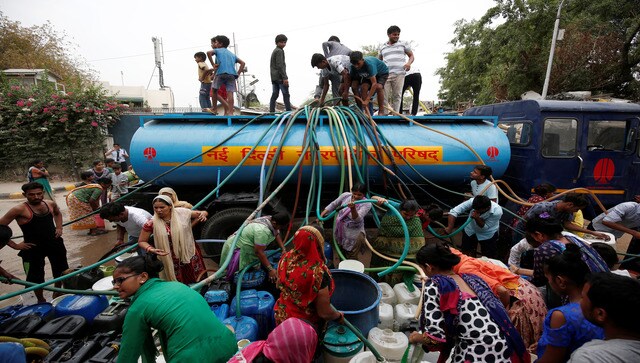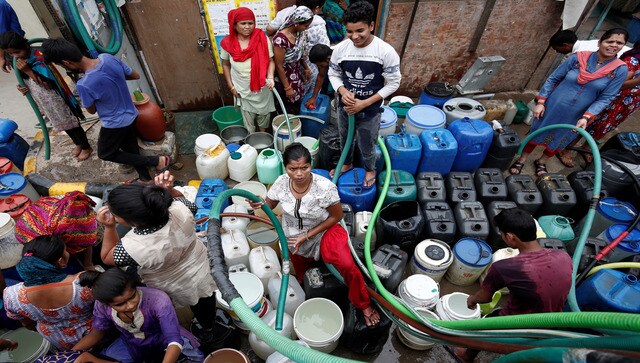Delhi minister Atishi warns of ‘severe’ water shortage: What’s behind the recurring crisis?
Delhi minister Atishi warns of ‘severe’ water shortage: What’s behind the recurring crisis?

Delhi water minister Atishi has flagged concerns about the city facing a likely “severe” drinking water shortage soon. On Tuesday (21 November), the Aam Aadmi Party (AAP) minister accused Delhi chief secretary Naresh Kumar of directing the finance department to stop funds to the Delhi Jal Board (DJB), reported The Hindu.
She called on Delhi Lieutenant Governor (LG) VK Saxena to intervene immediately and release funds to the DJB. “On the request of the chief secretary, finance secretary Ashish Verma stopped all the funds of the Jal Board from August. Funds are not being released even after the written order of the finance minister,” Atishi said, as per Indian Express.
The finance department and the DJB are at loggerheads after the board demanded an additional Rs 1,800 crore funds than the allotted budget, reported Indian Express.
She said that the staff have not been paid for months, adding that the Jal Board did not have funds “even for salary and routine work”. “There may be severe water shortage, dirty water, and sewer overflow in many areas in the coming days. There is a threat of an epidemic. This is an emergency situation,” Atishi cautioned.
Her warning has once again put the spotlight on the National Capital’s water troubles. Let’s take a closer look at why Delhi has a recurring water problem.
How much water does Delhi need?
Around two crore residents of Delhi need an estimated 1,300 MGD (millions of gallons per day) of water. However, the Jal Board can provide only 1,000 MGD, thus triggering a shortage in several areas, PTI reported.
The city requires a total of 274 litres per capita daily (LPCD) of water to fulfill the needs of its domestic consumers as well as commercial establishments, such as industries, hotels and others.
Delhi chief minister Arvind Kejriwal said this June that the DJB’s water supply capacity rose from 850 MGD in 2015 to the current 1,000 MGD, adding that this would be further enhanced to 1,200-1,300 MGD within two to three years.

As per Times Now, the three water treatment plants (WTP) supplying water to Delhi produce 230 MGD daily, of which 90 MGD is from Chandrawal, 120 MGD from Wazirabad, and the rest from Okhla.
The DJB’s water resources include the Yamuna and Ganga rivers, ground water, tube wells, and so on. It runs nine water treatment plants, 16 ranney wells and about 4,700 tube wells. In places where there is water scarcity, the DJB meets the demand through 1,200 tankers, as per PTI.
Why Delhi faces frequent water crisis
The problem of water shortage in Delhi is not new. As per ABC News, years of population growth, drought and mismanagement have exacerbated the city’s water crisis. The situation worsens in summer when temperatures touch record highs. People can be seen queueing up to get water from large tanks.
Experts blame Delhi’s massive urbanisation in the recent decades by neglecting the city’s natural water resources. As per The Guardian report, the National Capital’s 1976 master plan had 201 natural drains, however, only 44 were traceable in 2017. The speedy concretisation of Delhi has added to the intense heat during summer.
This has led to several water bodies drying up, including natural drains or nullahs, depletion of water table, preventing rainfall from penetrating the ground and recharging aquifers, reported the British daily.

Unregulated extraction of water is also an issue in the city. Groundwater in 15 of Delhi’s 27 administrative divisions is reportedly “overexploited”. Some private businesses have exploited the problem in water deficit areas by constructing illegal borewells.
In July, parts of the National Capital again faced a water shortage after the three WTPs were closed as rising water levels in the Yamuna inundated the equipment at these plants.
Steps to resolve Delhi’s water crisis
In September, the Delhi government said it would divert money from other departments to the DJB to fund its plan to provide 24×7 piped water and set up reverse osmosis (RO) purification plants in water deficit areas, reported Times of India (TOI).
Kejriwal said in June that his government will install tube wells in places with high water tables to extract water on a major scale. To recharge groundwater, lakes will be revived with treated sewage treatment plant (STP) water. This recharged water will be further treated in RO plants before being supplied to households, the Delhi CM said, as per PTI.
The Delhi government also decided to deploy treated wastewater for other purposes like gardening, road cleaning and at construction sites. Presently, the STPs in the city release 514 MGD of treated waste water, out of which 267 MGD is diverted to the Yamuna river and 90 MGD is used for horticulture purposes, reported the news agency.
With inputs from agencies
What's Your Reaction?

























































